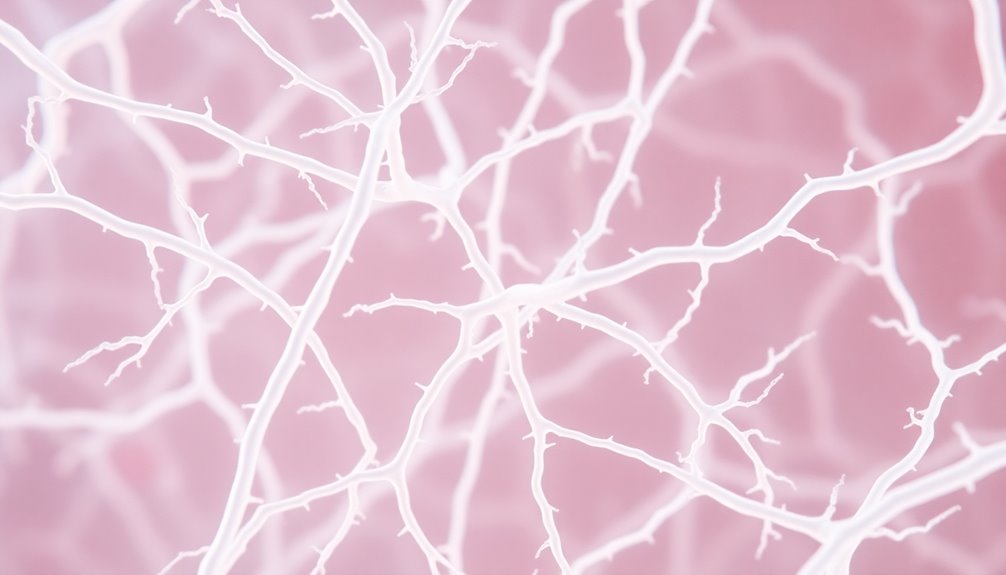Collagen Type VII is essential for your connective tissue, keeping your bodily structures strong and intact. Mutations in the COL7A1 gene can lead to skin fragility and blistering disorders, emphasizing the critical role of this collagen in maintaining tissue integrity. Additionally, understanding the associations between Collagen Type VII and blistering diseases is necessary for accurate diagnosis and effective management. Whether the focus is on therapeutic implications, ocular health implications, autoimmune diseases, or tissue integrity, delving deeper into the role of Collagen Type VII in various aspects of health can provide valuable insights and opportunities for targeted treatments.
Key Takeaways
- Collagen Type VII crucial for anchoring fibrils in skin and mucous membranes.
- Mutations in COL7A1 gene lead to connective tissue fragility and blistering disorders.
- Defects in type VII collagen affect tissue integrity and structural stability.
- Autoimmune conditions targeting Collagen Type VII disrupt connective tissue function.
- Understanding Collagen Type VII's role aids in targeted therapies for connective tissue diseases.
Genetic Variations and Disease Associations
If you carry genetic variations in the COL7A1 gene, you may be at risk for developing disorders like dystrophic epidermolysis bullosa. Mutations in the COL7A1 gene can impact the production of type VII collagen, essential for maintaining skin integrity.
Over 700 distinct mutations in COL7A1 have been linked to various forms of epidermolysis bullosa, leading to blistering disorders. Individuals with severe generalized blistering diseases due to these mutations face an increased risk of developing metastatic squamous cell carcinomas.
These genetic variations not only affect connective tissue but also play a significant role in skin health. Defects in type VII collagen, which is encoded by COL7A1, are responsible for inherited blistering diseases like dystrophic epidermolysis bullosa.
Understanding these associations between genetic variations in COL7A1 and blistering disorders is critical for early diagnosis and management of conditions impacting skin health.
Therapeutic Implications and Research Focus
Protein-based therapies and gene delivery offer promising avenues for treating individuals affected by dystrophic epidermolysis bullosa (DEB) resulting from defects in type VII collagen. Research on type VII collagen gene delivery has shown a reduction in blistering phenotype in preclinical studies, indicating a potential therapeutic benefit.
Patients with recessive DEB face a higher risk of developing epidermal cancers due to type VII collagen mutations, highlighting the pressing need for effective treatments. Ongoing studies are focused on establishing phenotype-genotype correlations in DEB to enhance genetic counseling and treatment approaches.
Understanding the impact of genetic variations in COL7A1 on skin health is essential for developing targeted therapies for collagen-related diseases. By delving into these areas, researchers aim to improve the quality of life for individuals with DEB and advance the field of connective tissue disorders through innovative therapeutic strategies.
Collagen Type 7 in Ocular Health
Within the intricate web of ocular health, Collagen Type 7 plays an important role in maintaining the structural integrity of various eye tissues. Mutations in the COL7A1 gene can lead to ocular complications such as clouded corneas and blister formation. Collagen Type 7 is present in the corneal, limbal, and conjunctival epithelia, necessary for maintaining the health of these tissues.
In severe cases of epidermolysis bullosa, the loss of anchoring fibrils in the eye occurs due to defects in Collagen Type 7. These anchoring fibrils connect basement membranes to anchoring plaques in ocular tissues, ensuring stability. Additionally, autoimmune conditions like epidermolysis bullosa acquisita can target Collagen Type 7, leading to ocular manifestations.
Understanding the significance of Collagen Type 7 in ocular health is essential for managing conditions related to connective tissue disorders and genetic mutations affecting this important protein.
Autoantibodies to Collagens in Autoimmune Diseases
When discussing autoimmune diseases, the presence of autoantibodies targeting specific proteins can provide essential insights into disease mechanisms. In conditions like epidermolysis bullosa acquisita (EBA), autoimmunity is directed against type VII collagen, specifically the COL7 alpha chains. This autoimmune response leads to the formation of immune deposits within the sublamina densa zone, a diagnostic feature of EBA.
Significantly, collagen type VII plays a critical role in anchoring fibrils, essential for skin integrity. The presence of autoantibodies against collagen VII can result in skin fragility, as observed in EBA and other autoimmune blistering diseases such as dermatitis herpetiformis.
Understanding the interplay between autoantibodies and collagen in autoimmune diseases sheds light on the pathogenesis of conditions characterized by connective tissue abnormalities. By targeting specific components like type VII collagen, the immune system disrupts the structural integrity of tissues, leading to clinical manifestations such as skin fragility in EBA.
The intricate relationship between autoantibodies and collagen underscores the complexity of autoimmune blistering diseases and emphasizes the importance of investigating these mechanisms in the quest for effective treatments.
Role in Tissue Integrity and Diseases
Type VII collagen plays a vital role in maintaining the structural integrity of tissues, particularly in the cohesion of the dermal-epidermal basement membrane zone. This collagen interacts with laminin-332 and other extracellular matrix proteins to provide essential structural support. Mutations in the COL7A1 gene, which encodes type VII collagen, can lead to skin fragility and blistering diseases such as epidermolysis bullosa.
Type VII collagen forms anchoring fibrils that are essential for skin stability at the dermal-epidermal junction. Defects in type VII collagen can result in complications like squamous cell carcinomas. Understanding the significance of type VII collagen in maintaining skin integrity and its role in various blistering diseases highlights its importance in the overall health of connective tissues. Researchers continue to investigate how targeted therapies can potentially address disorders associated with abnormalities in type VII collagen to improve patient outcomes.
Conclusion
To sum up, collagen type VII plays a vital role in maintaining the integrity of connective tissue and has been linked to various diseases and conditions. Understanding the genetic variations associated with collagen type VII can provide insights into disease mechanisms and potential therapeutic targets. Further research on the role of collagen type VII in ocular health and autoimmune diseases may lead to advancements in treatment options and improved patient outcomes.


